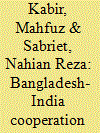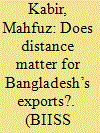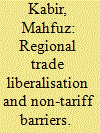|
|
|
Sort Order |
|
|
|
Items / Page
|
|
|
|
|
|
|
| Srl | Item |
| 1 |
ID:
176415


|
|
|
| 2 |
ID:
118185


|
|
|
| 3 |
ID:
159610


|
|
|
|
|
| Summary/Abstract |
Geographical proximity plays an important role in international trade. The gravity model of modern trade theory reveals that the closer the two countries the greater the volume of their bilateral trade. Bangladesh’s export trade has demonstrated impressive performance over the last one and a half decades. The exports are still dependent heavily on Readymade Garments (RMGs) for which the major destinations are distantly located countries, which is opposite to the prediction of the gravity model. Geographical diversification in destination has become an important policy priority for the existing mix of export items in the current and recent past export policies of the country, which is supposed to reverse the current role of distance. Given this context, the present paper is an attempt to examine whether the direction of distance has changed in the country’s export with panel data econometric model. An export weighted distance index has been developed to reveal the relative change in economic geography of Bangladesh for its major export destinations. The empirical results reveal that the policy initiatives of geographical diversification have obtained mixed results, but they have not been significantly successful to reverse the direction of distance in exports.
|
|
|
|
|
|
|
|
|
|
|
|
|
|
|
|
| 4 |
ID:
142741


|
|
|
|
|
| Summary/Abstract |
Export diversification helps a country to increase export earnings and create employment opportunities, especially in labour-intensive export sectors. Product and geographical diversifications are believed to be associated with reduced volatility in export earnings and vulnerability to sharp declines in terms of trade in developing countries. Bangladesh has witnessed remarkable export growth over the last two decades. However, despite policy indicatives for diversification, exports are overly dependent on readymade garments and concentrated to European Union and North American markets. Given this backdrop, the present paper tries to derive empirical evidence on whether the level of export diversification has positive linkage with export growth in Bangladesh. In doing so, it adopts time series econometric techniques to estimate an export supply function. The empirical results reveal that even though export diversification has positive but statistically insignificant linkage with quantity of export supplied in the world market, Bangladesh should pursue the ongoing policy measures to realise statistically significant benefits of export diversification in the long run.
|
|
|
|
|
|
|
|
|
|
|
|
|
|
|
|
| 5 |
ID:
143825


|
|
|
|
|
| Summary/Abstract |
The body of theoretical and empirical literature suggests that economic regionalism is beneficial for trade flows. The fundamental analytical questions are whether the groups demonstrate significant impetus to expand intra-bloc trade and whether trade liberalisation within the regional arrangement results in non-trivial mutual gains. To address these queries, this paper investigates the trading pattern and potential of Bay of Bengal Initiative for Multi-Sectoral Technical and Economic Cooperation (BIMSTEC). It adopts a stochastic trade frontier approach to an augmented panel gravity model. The results reveal that imports of the member countries follow the Linder hypothesis, while exports can be explained by Heckscher-Ohlin-Samuelson theorem. Controlling for behind and beyond the border constraints, the results of a stochastic frontier gravity model also support these findings. Such constraints are found to explain most of the total variation in imports and exports. The results also suggest that the highest trade potential, estimated by the frontier gravity model, turns out to be significant. Also, members of the group can substantially expand intra-BIMSTEC trade if the constraints are either removed or kept at the minimum.
|
|
|
|
|
|
|
|
|
|
|
|
|
|
|
|
| 6 |
ID:
078103


|
|
|
| 7 |
ID:
113377


|
|
|
|
|
| Publication |
2011.
|
| Summary/Abstract |
Currently, the government of Bangladesh is interested to strengthen economic ties with African countries through pursuing its 'Look Africa' policy. It is widely perceived that Bangladesh has considerable untapped economic potential in African countries which are endowed with abundant oil, minerals and agricultural land. By undertaking a field-based primary investigation, this paper attempts to examine the potential of Bangladesh's investment in Agricultural sector in Liberia, an African country with plentiful agricultural land. It suggests that Bangladesh can benefit from both full and joint-venture investment in rice, other food grains, fruit production, and agro-processing industries.
|
|
|
|
|
|
|
|
|
|
|
|
|
|
|
|
| 8 |
ID:
170620


|
|
|
|
|
| Summary/Abstract |
The convergence of interests and shared sense of connectivity between Bangladesh and India have opened up potential of new business corridors between the former and the latter’s Northeast. But three states in that region, viz. Mizoram, Manipur and Nagaland are not engaging with Bangladesh like Tripura, Assam and Meghalaya; which needs to be addressed to unlock the potentials since both Bangladesh and Northeast India have been given importance in India’s ‘Act East Policy’. Enhancement of trade, investment, connectivity, energy, cultural exchanges, etc. are possible with seamless transport and communication network. The paper suggests that India’s Northeast serves as an easy source of raw materials and intermediate products for different industries in Bangladesh. Advanced infrastructural development with inland water connectivity, rail and road transportation will boost bilateral trade relations and open up more business opportunities with relatively less connected states of India’s Northeast.
|
|
|
|
|
|
|
|
|
|
|
|
|
|
|
|
| 9 |
ID:
132377


|
|
|
|
|
| Publication |
2013.
|
| Summary/Abstract |
Bangladesh is geographically located between two Asian economic power houses - China and India. The gravity model of international trade theory implies that geographical proximity leads to higher volume of bilateral trade. However, very little or no trade takes place among the smaller countries in South Asia that are closely located even though individually they trade more with distant industrialised countries. This clearly implies that there may be other factors, such as lack of transport connectivity and related logistical constraints that give rise to high transaction costs leading to low trade. Nevertheless, Bangladesh has the potential to establish itself as a regional economic and financial hub. It has also been stipulated in the Vision 2021 of the Government of Bangladesh and demonstrated political will through a number of initiatives. Given this backdrop, this paper tries to explain the avenues for tapping the potential of Bangladesh's location through greater connectivity. It also attempts to uncover the whole issues of connectivity given the locational advantage of Bangladesh, identifies the existing bottlenecks that are hindering in deriving multiple economic benefits and suggests how to address these constraints. It reveals that the country has got unique location in the middle of two economic power houses, which, if wisely utilised, can provide wide ranging benefits to vibrate economically.
|
|
|
|
|
|
|
|
|
|
|
|
|
|
|
|
| 10 |
ID:
134110


|
|
|
|
|
| Publication |
2014.
|
| Summary/Abstract |
Although trade liberalisation measures are in place for eight years, intraregional trade in South Asia has been meagre and is not encouraging at all as Bangladesh's export market in the region. India also granted duty free quota free access to almost all traded Bangladeshi products, which is also not showing significant increase in Bangladesh's export to reduce the country's mounting trade deficit with India. Therefore, overwhelming presence of non-tariff barriers has been perceived to be resulted in intra-regional trade significantly lower than expected. Given this context, the paper tries to identify the non-tariff barriers in South Asia in the context of Bangladesh's export expansion in this region. It takes a few product-specific cases in both export and import of Bangladesh to examine the barriers prevailing in neighbouring countries, viz. India, Nepal and Bhutan. The paper reveals that such barriers are related to bonded warehouse, gate pass, shipment and customs, infrastructure in land customs stations, visa, speed money, and excessive checking, which have been suggested to constrain expected gains from regional trade liberalisation measures. The paper argues that India's countervailing duty on garments import has not impacted negatively on Bangladesh's exports, but there is scope for further improvement if the duty is set equally for Indian and foreign manufacturers.
|
|
|
|
|
|
|
|
|
|
|
|
|
|
|
|
| 11 |
ID:
138558


|
|
|
|
|
| Summary/Abstract |
This paper is an attempt to understand the prospect for strengthening rice seeds cooperation between Bangladesh and India in modern varieties. Both the countries are trying to achieve food security through improvements in rice production, marketing, and research and development in rice seeds. Bangladesh and four states of eastern India belong to similar agro-climatic zone where rice is overwhelmingly placed as a major staple food. However, due to absence of policy and regulatory barriers to rice seeds trade in modern varieties, there are anecdotal evidences of informal flow of rice seeds across the border, which is risky for both producers and consumers. The paper finds that there is a notable presence of informal cross-border trade of many varieties of rice seeds in three bordering districts in Bangladesh. The paper suggests some doable measures to strengthen rice seeds cooperation between the two countries through, inter alia, trade formalisation, making use of SAARC seed bank, joint research and release of new modern varieties, and harmonising standards and certification procedures.
|
|
|
|
|
|
|
|
|
|
|
|
|
|
|
|
| 12 |
ID:
103270


|
|
|
|
|
| Publication |
2011.
|
| Summary/Abstract |
One of the recent foreign policy priorities of the Government of Bangladesh is to consider Africa as a major region of huge economic potential. This paper examines the potential of Bangladesh's exports to African countries by adopting an augmented stochastic frontier gravity model. It reveals significant export potential in some selected African countries, which can be utilized by removing 'behind the border' constraints. The paper also explores the investment potential in the African countries to benefit backward linkage industries of Bangladesh as well as to create employment in agriculture, food processing and pharmaceutical industries. It reveals that Bangladesh can export considerable number of skilled professionals and semi-skilled workers in the mineral and service sectors in African countries by strengthening mutual cooperation.
|
|
|
|
|
|
|
|
|
|
|
|
|
|
|
|
|
|
|
|
|